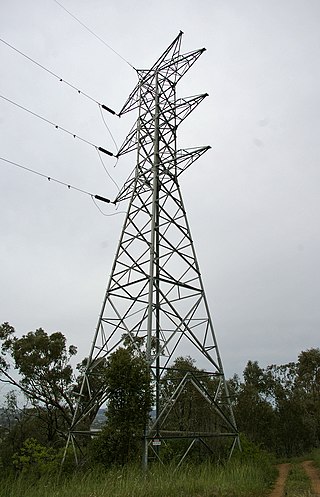The New Zealand electricity market (NZEM) is a decentralised electricity market regulated by the Electricity Industry Participation Code administered by the Electricity Authority (EA). The authority was established in November 2010 to replace the Electricity Commission.
The British Columbia Hydro and Power Authority, operating as BC Hydro, is a Canadian electric utility in the province of British Columbia. It is the main electricity distributor, serving more than 4 million customers in most areas, with the exception of the City of New Westminster, where the city runs its own electrical department and portions of the West Kootenay, Okanagan, the Boundary Country and Similkameen regions, where FortisBC, a subsidiary of Fortis Inc. directly provides electric service to 213,000 customers and supplies municipally owned utilities in the same area. As a provincial Crown corporation, BC Hydro reports to the BC Ministry of Energy, Mines and Low Carbon Innovation, and is regulated by the British Columbia Utilities Commission (BCUC). Its mandate is to generate, purchase, distribute and sell electricity.

Ontario Hydro, established in 1906 as the Hydro-Electric Power Commission of Ontario, was a publicly owned electricity utility in the Province of Ontario. It was formed to build transmission lines to supply municipal utilities with electricity generated by private companies already operating at Niagara Falls, and soon developed its own generation resources by buying private generation stations and becoming a major designer and builder of new stations. As most of the readily developed hydroelectric sites became exploited, the corporation expanded into building coal-fired generation and then nuclear-powered facilities. Renamed as "Ontario Hydro" in 1974, by the 1990s it had become one of the largest, fully integrated electricity corporations in North America.

The Electricity Supply Board is a state owned electricity company operating in the Republic of Ireland. While historically a monopoly, the ESB now operates as a commercial semi-state concern in a "liberalised" and competitive market. It is a statutory corporation whose members are appointed by the government of Ireland.
The British Electricity Authority (BEA) was established as the central British electricity authority in 1948 under the nationalisation of Great Britain's electricity supply industry enacted by the Electricity Act 1947. The BEA was responsible for the generation, transmission and sale of electricity to area electricity boards, and the development and maintenance of an efficient, coordinated and economical system of electricity supply.

The Electricity Act, 2003 is an Act of the Parliament of India enacted to transform the power sector in India.

The State Electricity Commission of Victoria is a government-owned renewable electricity investment enterprise in Victoria, Australia. Originally a major energy supplier in the state, the SEC was privatised in the 1990s before being revived in 2023 to invest in renewable energy and storage.

Kerala State Electricity Board (KSEB) is an Indian public sector undertaking under the Government of Kerala that generates, transmits and distributes electricity in the state under government monopoly. Established in 1957, the agency comes under the authority of the Department of Power. It has been registered under Indian Companies Act 1956 during January 2011.

Gibraltar is a British Overseas Territory and city located at the southern tip of the Iberian Peninsula. It has an area of 6.7 km2 (2.6 sq mi) and is bordered to the north by Spain. The landscape is dominated by the Rock of Gibraltar, at the foot of which is a densely populated town area, home to some 32,688 people, primarily Gibraltarians.
The Manx Electricity Authority was a Statutory Board of the Isle of Man Government which generated and supplied electricity for the Isle of Man. In 2014 it became part of the Manx Utilities Authority when it was merged with the Isle of Man Water and Sewerage Authority.

The Electricity Commission of New South Wales, sometimes called Elcom, was a statutory authority responsible for electricity generation and its bulk transmission throughout New South Wales, Australia. The commission was established on 22 May 1950 by the Electricity Commission Act 1950 to take control of power generation in the State. The commission acquired the power stations and main transmission lines of the four major supply authorities: Southern Electricity Supply, Sydney County Council, the Department of Railways and the Electric Light and Power Supply Corporation Ltd, also known as the Balmain Electric Light Company, the owner and operator of Balmain Power Station. The commission was responsible for the centralised co-ordination of electricity generation and transmission in the State, and some local councils continued to be distributors of electricity only.

Tamil Nadu Electricity Board is a power generation and distribution company owned by Government of Tamil Nadu, India. It was created as a regulated monopoly under section 131 of the Electricity Act (2003) as a successor of the erstwhile Tamil Nadu Electricity Board. It is the largest State Electricity Board (SEB) in the country in terms of number of consumers.

Padiham Power Station was a coal-fired power station in Padiham, east Lancashire, England, which began operation in 1926 and generated power from 1927 until it was closed in 1993.
Central Electricity Regulatory Commission (CERC), a key regulator of the power sector in India, is a statutory body functioning with quasi-judicial status under sec – 76 of the Electricity Act 2003. CERC was initially constituted on 24 July 1998 under the Ministry of Power's Electricity Regulatory Commissions Act, 1998 for rationalization of electricity tariffs, transparent policies regarding subsidies, promotion of efficient and environmentally benign policies, and for matters connected Electricity Tariff regulation. CERC was instituted primarily to regulate the tariff of power generating companies owned or controlled by the Government of India, and any other generating company which has a composite scheme for power generation and interstate transmission of energy, including tariffs of generating companies.

King's Bastion is a coastal bastion on the western front of the fortifications of the British overseas territory of Gibraltar, protruding from the Line Wall Curtain. It is located between Line Wall Road and Queensway and overlooks the Bay of Gibraltar. It played a crucial role in defending The Rock during the Great Siege of Gibraltar. In more recent history the bastion was converted into a generating station which powered Gibraltar's electricity needs. Today it continues to serve the community as Gibraltar's leisure centre.

The electricity sector in the Philippines provides electricity through power generation, transmission, and distribution to many parts of the country. The Philippines is divided into three electrical grids, one each for Luzon, the Visayas and Mindanao. As of June 2016, the total installed capacity in the Philippines was 20,055 megawatts (MW), of which 14,348 MW was on the Luzon grid. As of June, 2016, the all-time peak demand on Luzon was 9,726 MW at 2:00 P.M. on May 2, 2016; on Visayas was 1,878 MW at 2:00 P.M. on May 11, 2016; and on Mindanao was 1,593 MW at 1:35 P.M. on June 8, 2016. However, about 12% of Filipinos have no access to electricity. The Philippines is also one of the countries in the world that has a fully functioning electricity market since 2006 called the Philippine Wholesale Electricity Spot Market(WESM) and is operated by an independent market operator.
Fleetwood power stations were two generating stations that supplied electricity to the town of Fleetwood, England and the surrounding area from 1900 to 1981. The first station was owned by the Fleetwood and District Electric Light and Power Syndicate and later by Fleetwood Urban District Council. The second station was owned and operated by the state following the nationalisation of the British electricity supply industry in 1948; this power station was decommissioned in October 1981.
Warrington power station supplied electricity to the town of Warrington, Lancashire and the surrounding area from about 1900 to 1979. The power station was initially developed by the Warrington and District Electric Light and Power Company Limited, this was taken over by Warrington Corporation, which operated the power station prior to the nationalisation of the British electricity supply industry in 1948. It was redeveloped several times to meet the increased demand for electricity.












